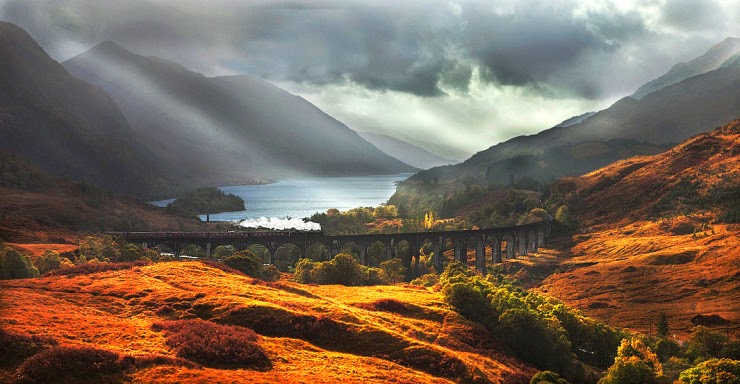The Scottish Highlands, a region of majestic landscapes and rich cultural heritage, captivates visitors with its rugged mountains, deep-blue lochs, and an enduring sense of mystique. Encompassing the northern and western parts of Scotland, the Highlands are a vast and sparsely populated area that showcases the untamed beauty of the Scottish countryside.
One of the most iconic features of the Highlands is its mountainous terrain. Towering peaks, including Ben Nevis, the highest mountain in the British Isles, dominate the landscape. The Highlands boast a diverse range of geological formations, from the sharp ridges of the Cuillin Hills on the Isle of Skye to the rolling hills of Glen Coe. These geological wonders offer endless opportunities for outdoor enthusiasts, with activities such as hiking, climbing, and skiing attracting adventurers from around the world.
The region is dotted with countless lochs, contributing to the serene beauty of the Highlands. Loch Ness, perhaps the most famous of them all, is renowned for more than just its scenic grandeur. Legend has it that the Loch Ness Monster, affectionately known as Nessie, lurks in its deep waters, adding an element of mystery and intrigue to the already captivating surroundings. Other notable lochs, such as Loch Lomond and Loch Maree, offer equally enchanting landscapes, providing a peaceful retreat for those seeking solace in nature.
The Scottish Highlands are steeped in history and tradition. Castles, some in ruins and others meticulously preserved, dot the landscape, each telling tales of battles, clan rivalries, and the turbulent history of the region. Eilean Donan Castle, perched on a small island at the confluence of three lochs, is a picture-perfect symbol of Highland history and resilience. Urquhart Castle, overlooking Loch Ness, is another poignant reminder of the region’s storied past.
The Highlands are also home to a unique and vibrant Gaelic culture. Traditional music, dance, and storytelling flourish here, and visitors have the opportunity to experience the warmth and hospitality of the Highland communities. The Highland Games, a series of traditional Scottish events featuring competitions in caber tossing, hammer throwing, and pipe and drum performances, provide a lively and colorful showcase of Highland culture.
Wildlife enthusiasts will find the Highlands to be a haven for diverse flora and fauna. Red deer, golden eagles, and red squirrels are among the many species that inhabit the rugged terrain. The Cairngorms National Park, the largest national park in the UK, encompasses a vast expanse of the Highlands and is a paradise for nature lovers, offering a chance to spot rare wildlife while traversing picturesque landscapes.
The allure of the Scottish Highlands extends to its scenic roadways, including the North Coast 500, a popular route that takes travelers on a circular journey through some of the most breathtaking landscapes in the region. The winding roads offer panoramic views of mountains, coastal cliffs, and charming villages, making it a must for road trip enthusiasts.
In conclusion, the Scottish Highlands stand as a testament to the raw and untamed beauty of nature. With its dramatic landscapes, rich history, and vibrant culture, the Highlands offer a captivating escape for those seeking adventure, tranquility, or a deep connection with the past. Whether scaling mountain peaks, exploring historic castles, or simply reveling in the serenity of a Highland loch, visitors to this remarkable region are bound to be enchanted by its timeless charm.
Mountains :
Ben Nevis, the highest peak in the British Isles at 1,345 meters, majestically dominates the Scottish Highlands. Nestled near the town of Fort William, its rugged slopes attract hikers and mountaineers year-round. Enshrouded in mist and snow-capped in winter, Ben Nevis offers a challenging ascent, rewarding those who conquer its summit with breathtaking panoramic views. Rich in geological and cultural significance, the mountain is an integral part of Scotland’s identity, drawing outdoor enthusiasts and nature lovers to experience its formidable beauty and the sense of accomplishment that comes with reaching the pinnacle of the United Kingdom’s loftiest peak.
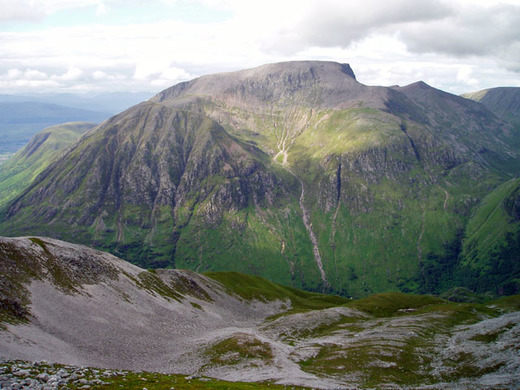
Ben Macdui, second only to Ben Nevis in height, rises majestically in the Cairngorms National Park, Scotland. Standing at 1,309 meters, this mountain’s remote and wild character beckons adventurers seeking solitude and challenging terrain. Its expansive plateau, shrouded in mist and dotted with granite tors, creates an otherworldly atmosphere. Ben Macdui is surrounded by tales of folklore, including the enigmatic “Grey Man,” adding an air of mystique to its formidable presence. Climbers are rewarded with stunning vistas and a profound sense of isolation, making Ben Macdui a captivating destination for those drawn to the untamed beauty of the Scottish Highlands.
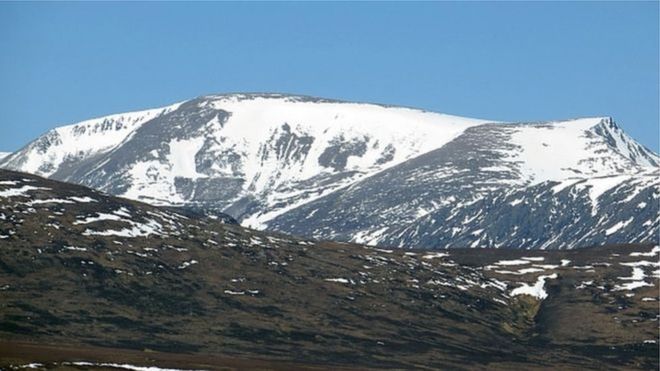
A few famous castles:
Dunrobin Castle, Golspie
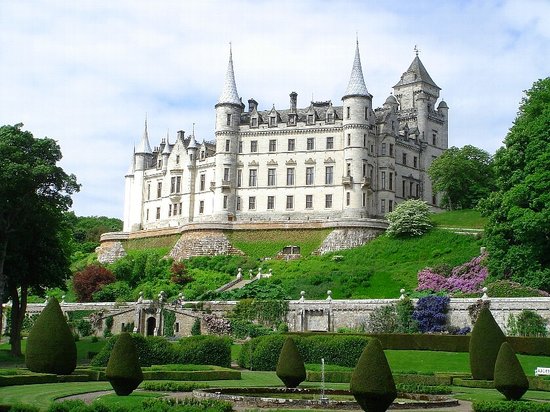
Dunrobin Castle, situated in Golspie in the Scottish Highlands, is a magnificent and historic fortress that stands as a testament to the region’s rich heritage. Perched on the northeast coast overlooking the North Sea, this fairytale-like castle is not only an architectural gem but also a living legacy of centuries of Highland history.
Built in the mid-19th century, Dunrobin Castle is the largest castle in the northern Highlands and holds the title of the most northerly of Scotland’s great houses. Its design draws inspiration from French chateaux, featuring conical spires, turrets, and a resplendent façade that reflects the romantic revival style of the Victorian era. The castle is surrounded by beautifully landscaped gardens, adding to its enchanting appeal.
The history of Dunrobin Castle can be traced back to the medieval era when it served as a stronghold for the Earls of Sutherland. Over the centuries, the castle underwent various transformations and expansions, with its current form reflecting the vision of Sir Charles Barry, the renowned architect behind the Houses of Parliament in London. The result is a stunning blend of medieval charm and Victorian opulence.
One of the highlights of a visit to Dunrobin Castle is the tour of its opulent interiors. The castle’s rooms are adorned with period furniture, tapestries, and an extensive collection of art and artifacts, providing a glimpse into the lives of the aristocracy that once called Dunrobin home. The drawing room, with its ornate ceiling and panoramic views of the surrounding grounds, is a particular standout, offering a taste of the grandeur that defines the castle’s interior.
The castle’s gardens are a work of art in themselves. Inspired by the gardens of Versailles, they feature terraced lawns, vibrant flower beds, and meandering pathways that lead to hidden corners and charming follies. The formal gardens lead seamlessly into the woodland beyond, creating a harmonious transition from the cultivated to the wild. The expansive grounds provide a delightful setting for leisurely strolls and are complemented by the backdrop of the castle and the dramatic coastline.
Dunrobin Castle is not merely a static monument but a living estate with its own resident falconer. Visitors can witness the artistry of trained birds of prey during falconry displays held on the castle grounds. These captivating demonstrations offer a unique and interactive experience, allowing guests to appreciate the ancient sport of falconry against the backdrop of the castle’s majestic architecture.
The castle is also a popular venue for events, including weddings and concerts. The grandeur of Dunrobin Castle provides a romantic setting for couples seeking a fairytale wedding, while its expansive lawns serve as a stage for musical performances that draw locals and visitors alike.
The location of Dunrobin Castle adds to its allure. Golspie, a small coastal village in the Highlands, offers a tranquil setting that complements the majestic surroundings of the castle. The nearby coastline provides opportunities for scenic walks, and the beach is a perfect spot for taking in the beauty of the North Sea.
In conclusion, Dunrobin Castle in Golspie, nestled within the breathtaking Scottish Highlands, stands as a symbol of architectural splendor and historical significance. Its fairy-tale appearance, rich interiors, and captivating surroundings make it a must-visit destination for those exploring the northern reaches of Scotland. Whether delving into its medieval roots, wandering through its manicured gardens, or marveling at the majestic birds of prey, visitors to Dunrobin Castle are transported to a world where history, art, and nature converge in perfect harmony.
Castle in Caithness.
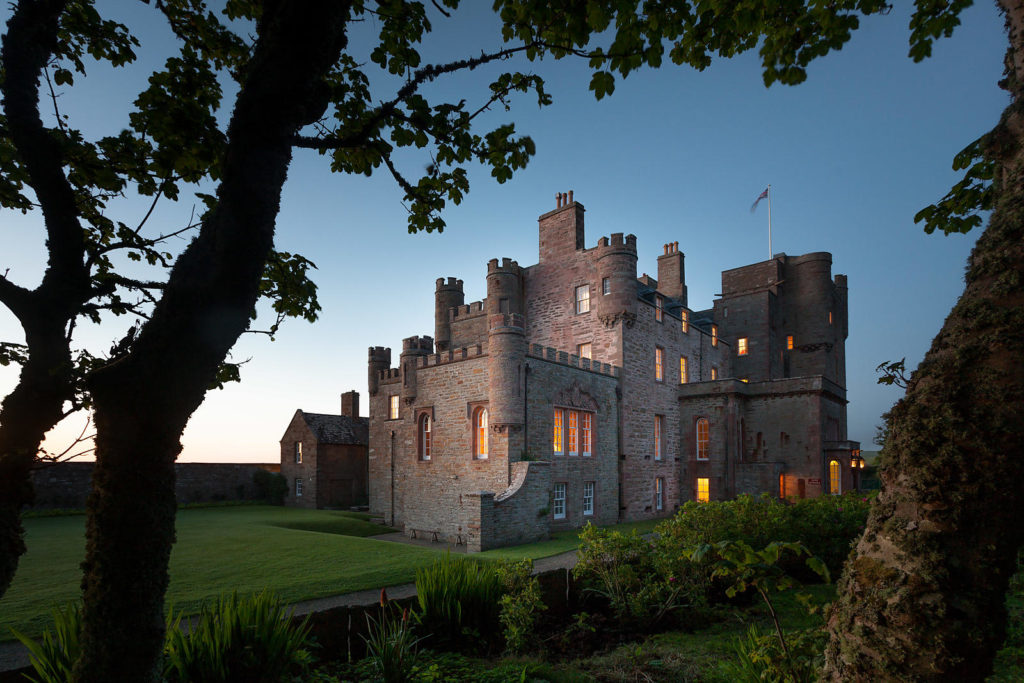
Caithness, in the northern reaches of Scotland, boasts Castle of Mey, a historic gem overlooking the Pentland Firth. Formerly a royal residence, it gained prominence when Queen Elizabeth, the Queen Mother, fell in love with its charm and restored it in the 1950s. This picturesque castle, with its distinctive pink sandstone, stands against a backdrop of rugged coastal beauty. The interior showcases a blend of opulence and homely touches, reflecting the Queen Mother’s influence. Visitors can explore elegant rooms, including the charming sitting room where the Queen Mother enjoyed panoramic views. The castle’s gardens, a riot of colors in summer, offer a tranquil escape. Today, Castle of Mey stands as a testament to a royal connection and a symbol of the enduring beauty of Scotland’s far north.
Moray and the Loch Ness
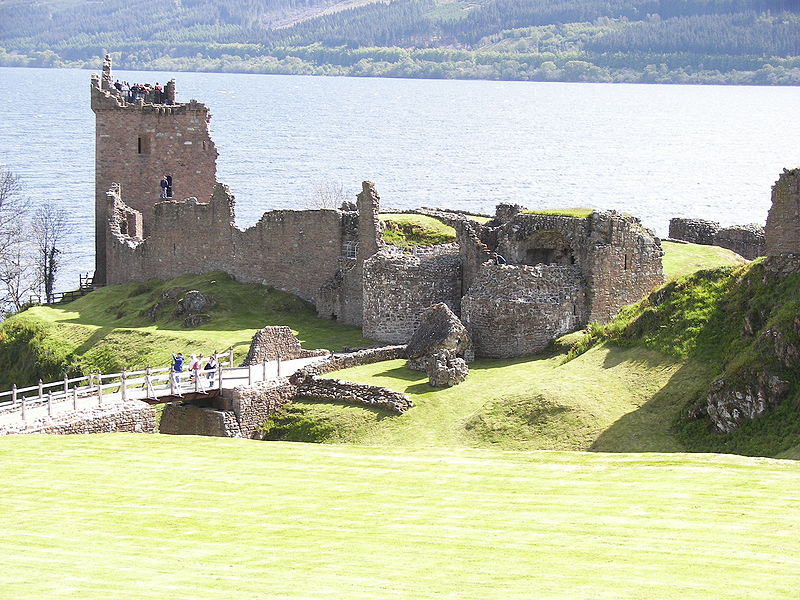
Urquhart Castle, perched on the shores of Loch Ness in the Scottish Highlands, is a historical marvel steeped in mystery and grandeur. With roots tracing back to the 13th century, this fortress witnessed centuries of conflicts, sieges, and strategic importance. The castle ruins, set against the dramatic backdrop of the Great Glen and the iconic Loch Ness, evoke a sense of medieval splendor and tales of Scottish history. Visitors can explore the tower, gatehouse, and remnants of the Great Hall, gaining insights into its past through interactive exhibits. The strategic location offers breathtaking views of Loch Ness, making it a prime spot for Nessie enthusiasts. Urquhart Castle stands not only as a testament to Scotland’s rich heritage but also as an enduring symbol of the country’s captivating landscapes and historical intrigue.
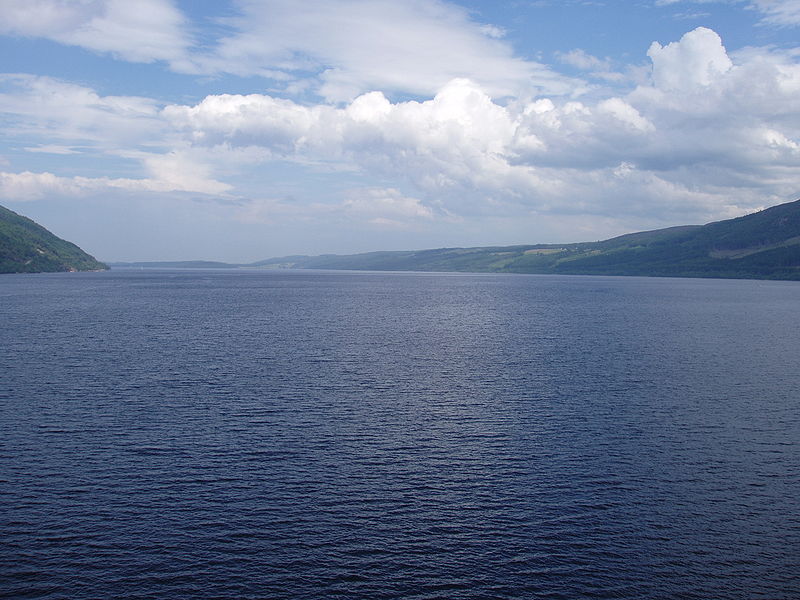
Le château de Cawdor
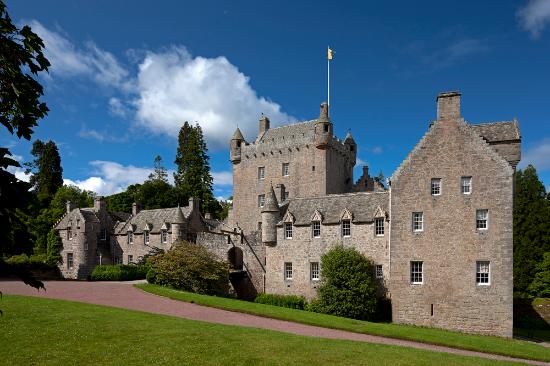
The castle of Cawdor, nestled in the Scottish Highlands, is a captivating historic fortress with a fairytale charm. Located near Inverness, its origins date back to the late 14th century, and the castle’s unique design showcases a seamless blend of medieval and Jacobean architecture. Surrounded by enchanting gardens and a renowned walled maze, the castle is renowned for its association with Shakespeare’s Macbeth, despite being built years after the events depicted in the play. Visitors can explore the opulent interiors, featuring a collection of period furniture and artwork. The beautiful surroundings, including the Cawdor Burn and the nearby woodlands, add to the castle’s allure. Le Château de Cawdor stands as a living testament to Scotland’s rich history and offers a glimpse into a bygone era amidst its atmospheric and picturesque setting.
Dunvegan Castle, Isle of Skye
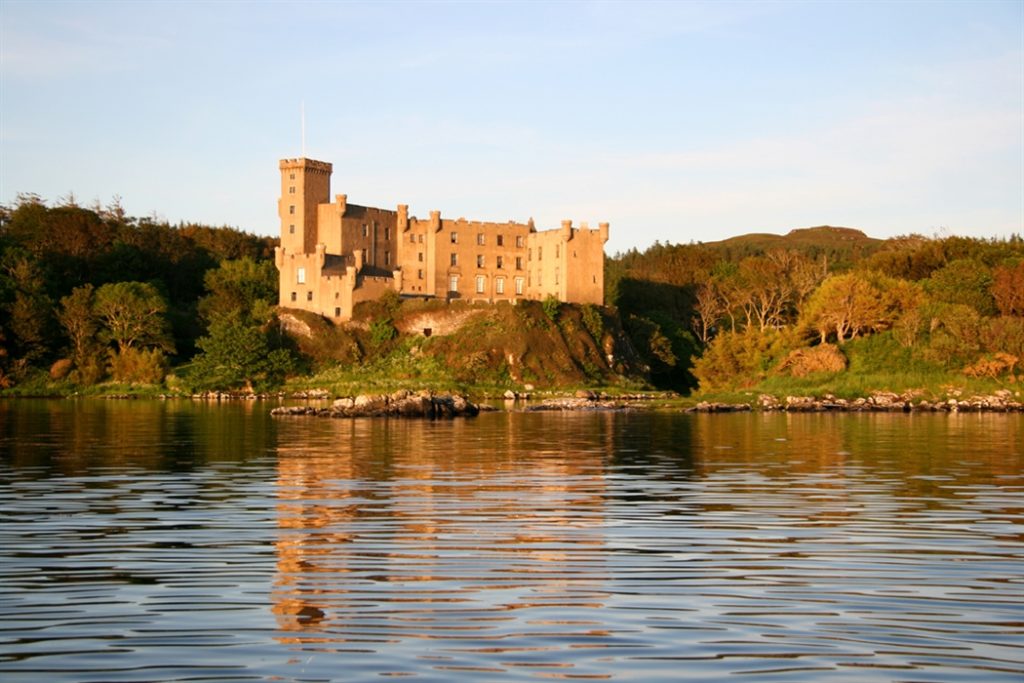
Dunvegan Castle, seated on the Isle of Skye in Scotland, is a storied fortress and the ancestral home of the Clan MacLeod for over 800 years. Perched on the shores of Loch Dunvegan, its picturesque setting and rich history make it a cornerstone of Highland heritage. The castle, with its distinctive fairy-tale turrets, encapsulates centuries of Scottish history and culture. Visitors can explore opulent rooms, home to clan artifacts and treasures, including the famous Fairy Flag. The castle’s stunning gardens, featuring exotic plants and panoramic views of the loch, add to its charm. As one of the oldest continuously inhabited castles in Scotland, Dunvegan Castle stands as a living testament to the resilience and enduring legacy of the MacLeod clan.
The castle of Eilean Donan
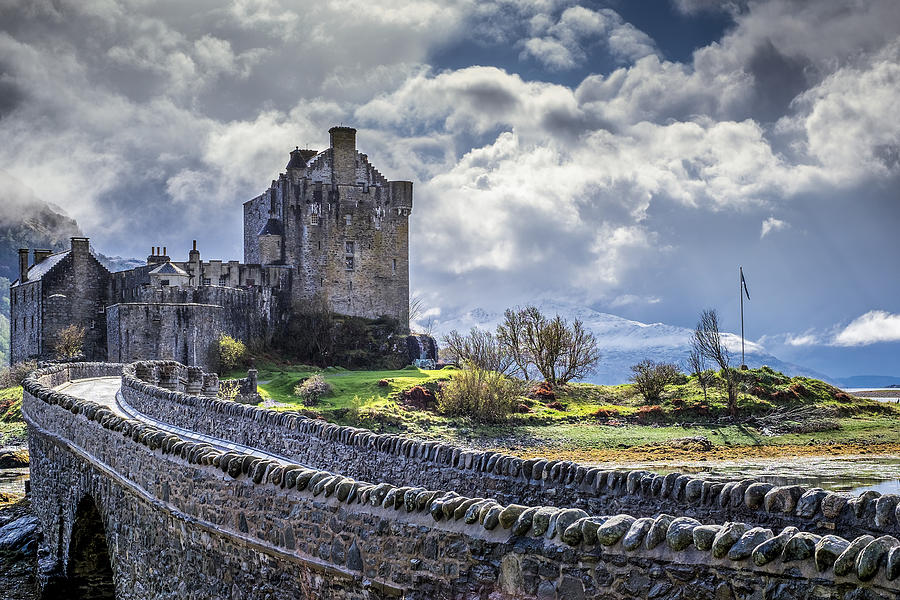
Eilean Donan, a captivating islet situated at the confluence of three lochs in the Scottish Highlands, hosts the iconic Eilean Donan Castle. Connected to the mainland by a stone bridge, the castle, with its fairytale silhouette against the Highland backdrop, is one of Scotland’s most photographed landmarks. Originally constructed in the 13th century, the castle has undergone reconstruction and restoration, seamlessly blending medieval and modern elements. Surrounded by the scenic beauty of Loch Duich, Loch Long, and Loch Alsh, Eilean Donan exudes a sense of timelessness and tranquility. Visitors can explore the castle’s interiors, housing artifacts and historical exhibits, while enjoying panoramic views of the mist-shrouded mountains and reflective waters. Eilean Donan Isle is a symbol of Scottish resilience and a testament to the enduring charm of Highland landscapes.

